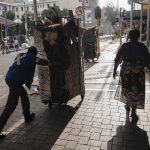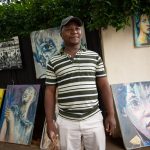Inner-city rent keeps low-income earners out
Joburg authorities claim that privatised redevelopment creates inexpensive homes. In the third part of our series, we discover what affordable means.
Author:
3 March 2020

Liberal sociologist Ellen Hellmann researched the overcrowded, unserviced black homes of Doornfontein – the “slumyards” – in the 1930s. Her photographs show tiny, multiple residences, divided by sacking and corrugated iron, crammed into former grand yards. Women draw water from a single pump to do washing in zinc tubs or brew traditional beer; children play at their feet.
Walk through Maboneng today, to a former commercial building on the corner of Janie Street, and you’ll see that, for some, not enough has changed. More than 40 rooms, subdivided by breeze-block walls that stop short of the roof, share three toilets. Women draw water from a standpipe to hang spotless washing on lines festooning the yard. Thobile Zondo, an activist for the Inner City Federation, which is affiliated with the Socio-Economic Rights Institute (Seri), lives there, and acknowledges the cramped, dusty conditions. But she has a home where she wants to be: in the city.
Hellmann’s interviewees stressed their proud determination to stay in the city, with its opportunities to earn for themselves and their families. Eighty years on, that hasn’t changed either.
Part one:
Unemployed carpenter Loyiso Sigaji, who lives in Linatex House, makes the point clearly. “There are never jobs in the townships. Here, everything is easier.” Even street trading is more viable, he says, given the busy city footfall. Themba, a security guard for the building who didn’t want his surname used, concurs. What’s more, “if you live in the city you meet people of all kinds. We encourage each other, give advice, and let life go along nicely. You can’t just live alone, you must interact; here we can do that. But there [in Maboneng] they chase us away.”
Guitarist Mpumelelo Mcata, a former Maboneng resident, also values that interactive vibe. “Maboneng offered something comparable to the kind of life [his band, Blk Jks] had enjoyed in New York. A coffee shop downstairs? It was cool. There’s a certain kind of energy that comes out of the mix – even the tensions – between different kinds of people. I want that kind of environment within the city.”
Jobs for sale
In the abstract, that was pioneer developer Jonathan Liebmann’s stated dream: recreating “the urbanism of street life” he had encountered overseas. Publicity for the development promised “[employment opportunities through] construction work in the buildings … cleaners … security, and through new businesses being set up”. The precinct property growth reports described a “community-focused inclusionary approach … collective encounters … new engagements … unique and energetic neighbourhoods”. In reality, over 60% of the development has been residential, and there has been little of the promised “inclusionary engagement” between low-income residents and more affluent incomers.
Employment patterns have shifted too: from small production to service providers whose recruitment carefully filters workers to suit the new clientele. “Before,” says Zondo, “there were many small firms here, like panel beaters. There used to be jobs. Now Maboneng is chasing those firms and their jobs to put in tenants. The rents are expensive … they want only celebrities in their restaurants. They don’t employ people from around here.”
Related article:
She and Motshwane see notices of vacancies and appointments going to the political loyalists of councillors from all parties, or the regional contacts of tenderpreneurs “sometimes from as far as KZN”. The Inner City Federation has also heard of job applicants rejected when it is discovered they live nearby. “Maybe they don’t want people from nearby knowing too much about what’s going on,” suggests treasurer Sifiso Zuma.
Even as a relatively affluent resident, Mcata (who has since moved out) began to feel what he calls “the cons of gentrification. I’d go down for a coffee, and get my picture taken and the next thing it appears in a Maboneng poster, holding that carton of milk. It was home for me, but a lot of the visitors on Sundays saw it as a human zoo. I couldn’t live with being a walking advert for the ‘coolness’ of the place … They are destroying the energy that comes from a mix of people. It’s getting over-policed.”
Inexpensive for whom?
Rising prices and costs and a wholly unrealistic notion of “affordability” are one mechanism of exclusion. Property24 lists an “affordable housing breakthrough” on the same road as Linatex House. Rent per month for a studio, sharing communal bathrooms, is R2 067, plus service levies of R135 and rates of R259. Other nearby apartments are in the R4 000 to R10 000 range – often with electricity extra – and rentals in some elite buildings rise far above that.
The official Extended Social Programme exists to provide support for impoverished renters. “But,” says Seri lawyer Khululiwe Bhengu, “assistance is means-tested and capped at R3 500. That doesn’t make sense: that if you are earning R3.5K you can afford to rehouse yourself or apply for low-cost housing – which is again a very complex bureaucratic process, with the housing not necessarily where you want to live.”
Informally employed people can provide an affidavit of earnings, but that is a prediction that may not materialise. And, says Siyabonga Mahlangu, secretary of the Inner City Federation, “the Housing Tribunal Act says rents shouldn’t be more than 30% of salary but the rents in even ‘affordable’ City housing are often half or more, excluding electricity. People still have to live on top of that. If you don’t pay, you’re evicted.”
Part two:
Seri’s Edward Molopi says the focus on inability to pay also ignores important, positive aspects of the inner-city economy. “If you look at the contribution poor people – the ones being evicted – make in the economy, it’s also significant. We’re removing a sector that’s already active, vibrant and contributing – already feeding families. What’s more, the life of those communities should be valued in more than monetary terms. What kind of value do we attach to human values and community life? Why promote only monetary value?” he asks.
On the margins of the newbuild area, small businesses still flourish: barbershops, tailors and more. In many buildings, residents have organised themselves to manage the day-to-day running. In Linatex House, residents have brought in a wooden hut so the security guard need not endure the freezing draughts of the hallway. Resident Loyiso Sigaji has used his skills to install a light in the dark, steep staircase and, with others, ensures the door to the dangerous flooded basement stays locked. He’d do more, he says, if he could buy materials. At the Janie Street building, residents share the tasks of keeping the place clean. “These pre-existing management systems,” says Molopi, “are something the City could leverage in upgrading buildings and cutting operating costs.”
The price of art
In its early years, Maboneng publicity lauded the creative economy it was hosting, showcasing galleries and artists. Some critics call this “artwashing”: corporate or municipal mimicking of organic inner-city art activities to distract from displacement and dispossession. When artist Mpumi Mathabela, from the gender activist organisation One in Nine, was part of a 2016 consortium painting a mural in another area, anxious residents fearing eviction confronted her team. “This has happened to us before,” they said. “Whenever they paint a mural, it’s the start of clearing us out.”
In South Africa and internationally, the arts can lure consumers and investors to an area ripe for profitable redevelopment. Part of Maboneng’s distinctive visual identity is its proliferation of wall art (often curated by developers or commercial advertisers) on buildings and hoardings, masking the changes within. “Artwashing” though, casts artists as willing accomplices when they are as often victims. Their presence signals, rather than causing, gentrification.
Related article:
“We’re workers too,” points out Mcata. “And actually we need next to nothing, which is why being offered a little studio space or something in Maboneng attracts us. But we aren’t living rich in those places, and if rents go up there, we are pushed out too. We get as desperate as anybody else!” Significant anecdotal evidence exists of how small arts activities originally based at the core of Maboneng have been squeezed out by rising costs. Sometimes, the artists are offered alternative, cheaper space on the new periphery. That puts them on the front line between low-income residents and developers, hiding where the real contradiction lies.
For Liebmann’s Propertuity, art was never more than a useful incidental. “A lot of regenerating communities have had artists as catalysts, which is good: artists play a role. But I think that in this modern corporatised world, there’s such an opportunity for business.” Sure enough, the real opportunities turned out to be for capital. Property values stalled and Propertuity’s debts soared. Sold off, its buildings only realised 50% to 80% of their target price. Other developers scooped up the bargains, moving aggressively to tie Maboneng into the global property economy.
There are now two visions for Joburg’s inner city: a capitalist fantasy, and the real aspirations of working people. We’ll conclude next week by discussing these.
Part four:
Correction, 11 March 2020: Guitarist Mpumi Mcata was erroneously referred to as Mpho Mcata.
Update, 13 March 2020: Mpumelelo Mcata was previously referred to as Mpumi Mcata.





